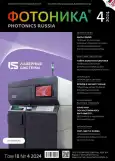Bibliometric analysis of academic literature on quantum information processing
- Authors: Terekhov A.I.1
-
Affiliations:
- Federal State Budgetary Scientific Institution “Central Economics and Mathematics Institute of the Russian Academy of Sciences”
- Issue: Vol 18, No 4 (2024)
- Pages: 296-312
- Section: Quantum Technologies
- URL: https://journals.eco-vector.com/1993-7296/article/view/634535
- DOI: https://doi.org/10.22184/1993-7296.FRos.2024.18.4.296.312
- ID: 634535
Cite item
Abstract
The milestones are reviewed and a bibliometric analysis of the research development in the field of quantum information processing in 1990–2020 is performed. The focus is on the global publication of research papers, productivity of certain countries and organizations, and international scientific cooperation. By means of bibliometric indicators, the following areas are considered: dynamic development of the area, a high concentration degree of research and international academic networking, participation of large-scale corporations in such networks along with the universities and academic institutions, especially from Japan and military research entities, primarily from the USA. Russia is characterized by the following: a high concentration of research in the metropolitan agglomerations and its significant internationalization; significant contribution of the Russian Academy of Sciences and the growing role of universities in the development of the scientific base of quantum technologies, as well as the still weak involvement of the Russian commercial sector in the research activities. The data sources for analysis have been the bibliographic databases: Web of Science Core Collection and SCOPUS.
Full Text
About the authors
Aleksander I. Terekhov
Federal State Budgetary Scientific Institution “Central Economics and Mathematics Institute of the Russian Academy of Sciences”
Author for correspondence.
Email: photonics@technosphera.ru
ORCID iD: 0000-0003-0266-1606
Ph.D. in physical and mathematical science, leading researcher
Russian Federation, MoscowReferences
- Editorial. 40 years of quantum computing. Nature Reviews Physics. 2022; 4(1). https://doi.org/10.1038/s42254-021-00410-6.
- Feynman R. P. Simulating Physics with Computers. International Journal of Theoretical Physics. 1982; 21(6/7): 467–488.
- Nil’sen M., CHang I. Kvantovye vychisleniya i kvantovaya informaciya. – M.: Mir. 2006. 824 p. (In Russ.) Нильсен М., Чанг И. Квантовые вычисления и квантовая информация. – М.: Мир. 2006. 824 с.
- Quantum Information Science. An Emerging Field of Interdisciplinary Research and Education in Science and Engineering. Report of the NSF Workshop. US, Virginia. 1999. URL: https://www.nsf.gov/pubs/2000/nsf00101/nsf00101.pdf.
- DiVincenzo, D. P. The physical implementation of quantum computation. Fortschritte der Physik – Progress of Physics. 2000; 48(9–11): 771–783. https://doi.org/10.1002/1521-3978(200009)48:9/113.0.CO;2-E.
- Montanaro A. Quantum algorithms: an overview. npj Quantum Information. 2016; 2: Article number 15023. https://doi.org/10.1038/npjqi.2015.23.
- Bova F., Goldfarb A., Melko R. G. Commercial applications of quantum computing. EPJ Quantum Technology. 2021; 8(2): 13 p. https://doi.org/10.1140/epjqt/s40507-021-00091-1.
- Kvantovye tekhnologii dlya gosudarstva i biznesa: nastoyashchee i budushchee. – M.: Fond Roskongress. 2023. 28 p. Квантовые технологии для государства и бизнеса: настоящее и будущее. – М.: Фонд Росконгресс. 2023. 28 с.
- Najafi K., Yelin S. F., Gao X. The Development of Quantum Machine Learning. Harvard Data Science Review. 2022; 4(1): 1–13.
- Krelina M. Quantum technology for military applications. EPJ Quantum Technology. 2021; 8(1): Article number 24. https://doi.org/10.1140/epjqt/s40507-021-00113-y.
- Groenland K. The professional’s guide to Quantum Technology. Part 5 – Timelines: When can we expect a useful Quantum Computer? 12 May 2023. URL: https://www.quantum.amsterdam/part-5-when-can-we-expect-a-useful-quantum-computer-a-closer-look-at-timelines/.
- Choi C. Q. IBM: Quantum computers are already doing heavy lifting. 22 Jun 2023. URL: https://spectrum.ieee.org/practical-quantum-computing-ibm.
- Poslanie Prezidenta RF Federal’nomu Sobraniyu ot 01.12.2016. Moskva. 01.12.2016. URL: http://www.consultant.ru/document/cons_doc_LAW_207978/. (In Russ.) Послание Президента РФ Федеральному Собранию от 01.12.2016. Москва. 01.12.2016. URL: http://www.consultant.ru/document/cons_doc_LAW_207978/.
- Fedorov A. K. Kvantovye tekhnologii: ot nauchnyh otkrytij k novym prilozheniyam. Fotonika. 2019; 13(6): 574–583. doi: 10.22184/1993-7296.FRos.2019.13.6.574.583. (In Russ.) Федоров А. К. Квантовые технологии: от научных открытий к новым приложениям. Фотоника. 2019; 13(6): 574–583. doi: 10.22184/1993-7296.FRos.2019.13.6.574.583.
- Witt S. The World-Changing Race to Develop the Quantum Computer. The New Yorker. Annals of Technology. 19 Dec 2022. URL: https://www.newyorker.com/magazine/2022/12/19/the-world-changing-race-to-develop-the-quantum-computer.
- Cartwright J. NSA keys into quantum computing. 06 Feb 2014. URL: https://physicsworld.com/a/nsa-keys-into-quantum-computing/.
- Wang J., Shen L., Zhou W. A bibliometric analysis of quantum computing literature: mapping and evidences from Scopus. Technology Analysis & Strategic Management. 2021; 33(11): 1347–1363. doi: 10.1080/09537325.2021.1963429.
- Scheidsteger T., Haunschild R., Bornmann L., Christoph E. Bibliometric analysis in the field of quantum technology. Quantum Reports. 2021; 3(3): 549–575. https://doi.org/10.3390/quantum3030036.
- Terekhov A. I. Kvantovaya obrabotka informacii: bibliometricheskij vzglyad. Prikladnaya informatika. 2019; 14(3): 55–65. doi: 10.24411/19938314201910015. (In Russ.) Терехов А. И. Квантовая обработка информации: библиометрический взгляд. Прикладная информатика. 2019; 14(3): 55–65. doi: 10.24411/19938314201910015.
- Bhushan B. Introduction to Nanotechnology. In: Springer Handbook of Nanotechnology. – Berlin, Heidelberg: Springer, 2017. P. 1–19.
- Editorial. Quantum nanoscience. Nature Nanotechnology. 2021; 16: 1293. https://doi.org/10.1038/s41565-021-01058-0.
- Terekhov A. I. Pozicionirovanie Rossii v poyavlyayushchihsya vysokotekhnologichnyh napravleniyah. Vestnik RAN. 2022; 92(1): 74–85. doi: 10.31857/S0869587322010091. (In Russ.) Терехов А. И. Позиционирование России в появляющихся высокотехнологичных направлениях. Вестник РАН. 2022; 92(1): 74–85. doi: 10.31857/S0869587322010091.
- The quantum state of affairs. Nature Physics. 2023; 19: 605. https://doi.org/10.1038/s41567–023–02072-w.
Supplementary files

















